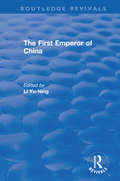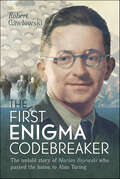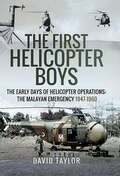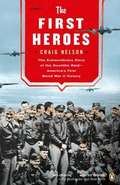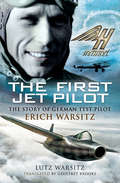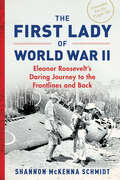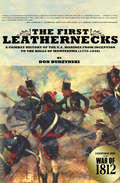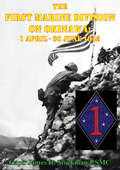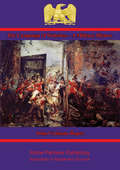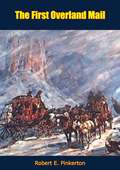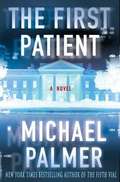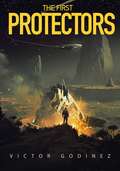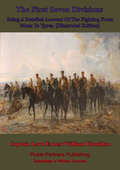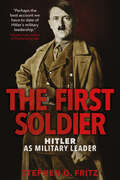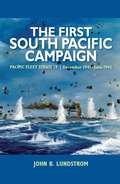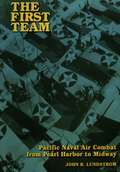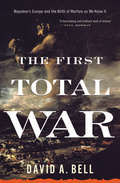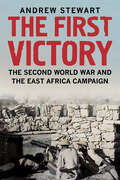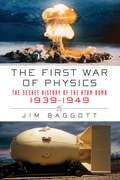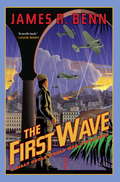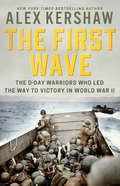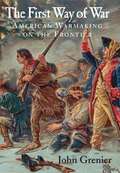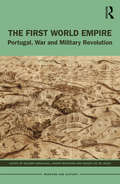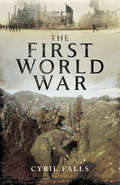- Table View
- List View
The First Emperor of China (Routledge Revivals)
by Li Yu-NingThis title was first published in 1975. The long history of China has produced many outstanding rulers, but few as significant as Ch'in Shih-huang, the first emperor of China. When he ascended the royal throne of Ch'in as King Cheng in 246 B.C., the territory of China was divided among several rival kingdoms, the last of a large number of states which had been engaged in almost uninterrupted warfare for centuries. Through a combination of warfare, diplomacy, and intrigue, King Cheng successively annihilated the rival six states, destroying the last in 221 B.C. Since 1972 a radically different official view of the First Emperor has been given prominence throughout China. Now he is seen as a farsighted ruler who destroyed the forces which had kept China divided, unified the nation, and established the first centralized state in Chinese history. This phenomenon prompts students of Chinese history and politics alike to ask; Is this only a historical controversy ? If not, what might be the motivation behind this movement? It is hoped that the materials in this volume, in addition to providing a representative sampling of the current reinterpretation of Ch'in Shih-huang, may also be helpful in formulating answers to the above and more questions.
The First Enigma Codebreaker: The Untold Story of Marian Rejewski who Passed the Baton to Alan Turing
by Robert GawlowskiThe First Enigma Codebreaker is the story of a man who started a revolution in cryptology and the conflict between man and machine. This is a powerful story of the life of Marian Rejewski and how history can affect individual lives, presented to the public for the first time. This examination of how Marian Rejewski changed the course of cryptology is of great interest to everyone from the avid historian to Hollywood film producers and all those in-between. As Gawlowski’s biography shows, Rejewski was an unassuming man who used his mathematical, skills as well as his extensive linguistic abilities, to start cracking the Enigma code before passing the baton on to the now renowned Alan Turing. This is a fascinating, human story about the man Marian Rejewski, which also ties up the loose threads of the Enigma story and shows the importance of the Polish involvement in that process. The First Enigma Codebreaker looks at those involved in cracking the Enigma and also takes a look at an aspect that has rarely been discussed in great detail, the story of Marian Rejewski himself, and how he endured life in post-war Communist Poland shining a light on situations such as how Rejewski managed to decode the machine, what happened to him during the Second World War, and the price he had to pay during the post war period.
The First Helicopter Boys: The Early Days of Helicopter Operations—The Malayan Emergency, 1947–1960
by David TaylorThe Indonesian Confrontation that raged from 1963 to 1966 stemmed from Indonesia’s opposition to the creation of Malaysia. Fighting in the challenging jungle terrain of Borneo and in the countryside straddling the Malaysia/Indonesia border, where there were few roads, posed significant logistical challenges to both sides. That the conflict was ultimately a victory for the Commonwealth forces was in due in no small part to the fact that they enjoyed the advantage of vastly superior helicopter resources and better trained crews – many of which were provided by British units. During the Confrontation, many of these vital helicopter assets were flown by pilots and crews who had gained their knowledge and experience firsthand during the Malayan Emergency, one of the Cold War’s first flash-points which had begun in 1948. Without doubt, the Malayan Emergency marked the formative years of the RAF’s and Royal Navy’s helicopter operations – the very early days in fact, when equipment and knowledge were much more basic. It was a time when operational procedures were still under development, even though the helicopters were already being flown on front line service. Told in the main through their own words, by the RAF and Royal Navy air and ground crews involved, this is the story of how these ‘guinea pigs’ undertook many of Britain’s first rotary wing combat operations and, therefore, cemented their rightful place in the history of the helicopter.
The First Heroes
by Craig Nelson18 April 1942. Sixteen planes take off from a US Navy carrier in the mid-Pacific. A squadron of young, barely trained flyers under a famous daredevil, Jimmy Doolittle, they are America's first retaliation towards Japan since Pearl Harbor. Their mission: to bomb Japan's 's five main cities including Tokyo. Critically compromised by the discovery of the US fleet by Japanese spies, they are not expected to come back. Having successfully delivered their bombs, most of the squadron run out of fuel and are forced to crash land in Japan, China and the Soviet Union. The stories of their journeys home are as heroic as that of the raid itself. Incredibly of the 80 flyers who left the USS . . . 90% eventually returned alive to the US. The First Heroes tells the extraordinary story of the daring raid and shows for the first time the real story of what was to be the turning point in the war against Japan.
The First Jet Pilot: The Story of German Test Pilot Erich Warsitz
by Lutz WarsitzOn 27 August 1939, Flugkapitan Erich Warsitz became the first man to fly a jet aircraft, the Heinkel He 178 and in June of the same year he flew the first liquid-fuel rocket aircraft, the Heinkel He 176. His legendary flying skills enabled him to assist the pioneering German aircraft and engine design teams that included Wernher von Braun and Ernst Heinkel. He repeatedly risked his life extending the frontiers of aviation in speed, altitude and technology and survived many life-threatening incidents.This book is written by Erichs son who has used his fathers copious notes and log books that explain vividly the then halcyon days of German aviation history. Warsitz was feted by the Reichs senior military figures such as Milch, Udet and Lucht and even Hitler keenly followed his experimental flying. Little is known of this pioneer period because of the strict secrecy which shrouded the whole project it is a fascinating story that tells of the birth of the jet age and flight as we know it today. The book includes many unseen photographs and diagrams.
The First Lady of World War II: Eleanor Roosevelt's Daring Journey to the Frontlines and Back
by Shannon McKenna SchmidtThe first book to tell the full story of Eleanor Roosevelt's unprecedented and courageous trip to the Pacific Theater during World War II.On August 27, 1943, news broke in the United States that First Lady Eleanor Roosevelt was on the other side of the world. A closely guarded secret, she had left San Francisco aboard a military transport plane headed for the South Pacific to support and report the troops on WW2's front lines. Americans had believed she was secluded at home.As Allied forces battled the Japanese for control of the region, Eleanor was there on the frontlines, spending five weeks traveling, on a mission as First Lady of the United States to experience what our servicemen were experiencing... and report back home."The most remarkable journey any president's wife has ever made."—Washington Times-Herald, September 28, 1943"Mrs. Roosevelt's sudden appearance in New Zealand well deserves the attention it is receiving. This is the farthest and most unexpected junket of a First Lady whose love of getting about is legendary."—Detroit Free Press, August 28, 1943"By a happy chance for Australia, this famous lady's taste for getting about, her habit of seeing for herself what is going on in the world, and, most of all, her deep concern for the welfare of the fighting men of her beloved country, have brought her on the longest journey of them all—across the wide, war-clouded Pacific."—Sydney Morning Herald, September 4, 1943"No other U.S. mother had seen so much of the panorama of the war, had been closer to the sweat and boredom, the suffering."—Time, October 4, 1943
The First Leathernecks
by Don BurzynskiThe First Leathernecks is an exciting and insightful recounting of the earliest and most formative phases in the history of the United States Marine Corps, including the War of 1812, a period in which the author is a recognized expert. Burzynski has gleaned what little information is available in documents from the time and filled in the blanks with his own extensive research and historical background. What has emerged from those efforts is one of the most thorough and interesting accounts of a pivotal period in American military history. The author's stirring prose is amplified by beautiful artwork created by noted Marine Corps historian and fine artist Charles Waterhouse. The book covers the earliest days of the nascent US Marine Corps and extends to their participation in the Mexican War of 1848, including the War of 1812. (This release is timed to coincide with the bicentennial year of that conflict, and the ensuing renewed interest.) Even readers relatively unfamiliar with this crucial period in American history will be fascinated by Burzynki's tale of Marine combat in the battles of Lake Erie, Bladensburg, Baltimore, and New Orleans. It was the Marines' accurate and devastating musketry, coupled with their skill at manning cannon aboard the American warships, that ensured victory in these battles with Great Britain. Despite their demonstrable value in those battles, their success in combating the slave trade while serving at sea with the US Navy, and their singular contribution in quashing piracy off the coasts of North Africa, the marines of the period were forced to fight for survival on home turf. Burzynski accurately and interestingly covers the internecine wars between marines, their supporters, and such luminaries as President Andrew Jackson and other politicians who often sided with American admirals eager to disband the corps. This is an exciting, exhilarating tale of the most formative years of the US Marine Corps. It goes a long way toward explaining how and why "Send in the Marines!" became a viable and reliable diplomatic ploy throughout the early years of American history.
The First Marine Division on Okinawa; 1 April - 30 June 1945 [Illustrated Edition]
by Capt. James R. Stockman USMCIncludes 32 mapsThe History of the 1st Marine Division or the "Old Breed" in the final campaign of the Pacific War.After many brutal struggles against the Japanese army on Guadalcanal, Solomon Islands, Cape Gloucester and Peleliu again, the Old Breed moved out, this time bound for Okinawa, a major island in the Ryukus only 350 miles from the southern Japanese home island of Kyushu. In the largest amphibious assault of World War II, Marine and Army units -- among them the First Marine Division -- landed on the Hagushi beaches on 1 April 1945. For most of April, the First was employed in a hard-driving campaign to secure the northern sections of Okinawa. On 30 April 1945, that all ended when the Old Breed went into the lines against the teeth of the Japanese defenses on the southern front.The Division smashed up against the Shuri Line, and in a series of grinding attacks under incessant artillery fire, reduced one supporting position after another. As May wore on, heavy rains flooded the battlefield into a sea of mud, making life misery for all hands. meanwhile, Japanese kamikaze attackers exacted a fearsome toll from the supporting ships offshore. Finally, on 31 May 1945, Marines of the First completed the occupation of Shuri Castle, nothing more than a pile of rubble after so many days of unrelenting combat.Under the overall command of Tenth Army, the Division continued the push south against the newly established enemy positions around Kunishi Ridge. Marine tank-infantry teams adopted a technique called "processing" to destroy Japanese positions with flame and demolitions. Finally, organized resistance ended on 21 June when the last Japanese defenses were breached. By now, many of the Old Breed's battalions had been reduced to nothing more than small rifle companies.
The First Napoleon; A Sketch, Political And Military
by John Codman RopesJohn Codman Ropes was not only a lawyer of the first order, but also a military history of great note. Intimately involved in supporting troops from his native Massachusetts in the American Civil War (he could not serve directly himself due to a childhood illness), he later diligently collected information on this conflict to produce the excellent "The Army under Pope" and the unfinished "Story of the Civil War". He was the driving force of the Military Historical Society of Massachusetts, whose members included large numbers of service men, notably General Hancock. From his wealth of expertise and knowledge, he produced two volumes on the Napoleonic period as well, both of which have gone on to become standard works.This volume details the outline of the startling career of Napoleon Bonaparte, from his noble but humble beginnings in Corsica to the heights of his power as Emperor of the French, and to his eventual demise in exile at St. Helena. Free from any of the rancorous or jingoistic undertones found in works emanating from the European belligerent nations such as France or England, the text is clear, lucid and entertaining. Despite being a "Sketch", it covers all the major areas of Napoleon's life, including his military, personal and political achievements that defined the policy in Europe for over a decade.Warmly recommended to a novice of the subject as well as an experienced Napoleonic campaigner.Title - The First Napoleon - A Sketch, Political and Military.Author -- John Codman Ropes (1836-1899)Illustrations -- 9 maps and plans.
The First Overland Mail
by Robert E. PinkertonFirst published in 1953, this book tells the story of John Butterfield, a mid-19th Century stagecoach and freight line operator and his line of stagecoaches, which took passengers and mail across the U.S. in the 1850s.Born on a farm in Berne, New York in 1801, Butterfield grew up on a farm and was mostly self-educated. At the age of 19, he became a professional stage driver. He was always interested in transportation, becoming involved in the livery business, establishing stage routes throughout New York. He also gained experience with steamboats, railroads, and local plank-roads.As a skilled businessman, he soon controlled most of the stage lines west of New York, and in 1849 he formed the companies that became American Express and Wells-Fargo, as well as the Butterfield Overland Stage Company.In 1857, American Express won the government contract for the first transcontinental stage line, carrying the mail from Missouri to California for $600,000 per year—the largest mail contract that had ever been awarded. Thus, Butterfield became president of the Overland Mail Company.Covering an exciting period in American history, this story of bravery and adventure will appeal to readers of all ages!
The First Patient
by Michael PalmerFrom the blockbuster New York Times bestselling author comes a high-concept, high-octane thriller at the crossroads of presidential politics and cutting-edge medicine. Gabe Singleton and Andrew Stoddard were roommates at the Naval Academy in Annapolis years ago. Today, Gabe is a country doctor and his friend Andrew has gone from war hero to governor to President of the United States. One day, while the United States is embroiled in a bitter presidential election campaign, Marine One lands on Gabe's Wyoming ranch, and President Stoddard delivers a disturbing revelation and a startling request. His personal physician has suddenly and mysteriously disappeared, and he desperately needs Gabe to take the man's place. Despite serious misgivings, Gabe agrees to come to Washington. It is not until he is ensconced in the White House medical office that Gabe realizes there is strong evidence that the President is going insane. Facing a crisis of conscience-as President Stoddard's physician, he has the power to invoke the Twenty-fifth Amendment to transfer presidential power to the Vice President- Gabe uncovers increasing evidence that his friend's condition may not be due to natural causes. Who? Why? And how? The President's life is at stake. A small-town doctor suddenly finds himself in the most powerful position on earth, and the safety of the world is in jeopardy. Gabe Singleton must find the answers, and the clock is ticking. With Michael Palmer's trademark medical details, and steeped in meticulous political insider knowledge, The First Patient is an unforgettable story of suspense.
The First Protectors: A Novel
by Victor GodinezThe last thing Ben Shepherd wanted was another war. But sometimes the universe won’t take no for an answer. His body and spirit mangled by a lifetime of combat, Shepherd, a retired Navy SEAL, has retreated to the desolate desert of New Mexico to heal his wounds and dodge his demons. All he wants now is peace and quiet. Both are shattered one starry night, when an alien ship crashes nearby. Out of the ship crawls the last, dying member of a conquered civilization. It’s been shot down by an extraterrestrial enemy, the vanguard of a ravenous force hunting for a new homeland. With its last gasp, the wounded alien injects Shepherd with a high-tech serum that gives him near superhuman powers. Now, with a new body but a soul as fractured as ever, Shepherd becomes the reluctant leader of the human resistance against the coming invasion. With enemies on all sides, the man who couldn’t bear the guilt of seeing one more friend die in battle now finds himself charged with protecting the entire planet.
The First Seven Divisions, Being A Detailed Account Of The Fighting From Mons To Ypres. [Illustrated Edition]
by Captain Lord Ernest William HamiltonThe opening of the First World War pitted the huge continental armies against each other; massed conscription filled their ranks, Britain's soldiers, however, were to a man volunteer, long-service professionals. Disciplined, few in number but thoroughly trained to shoot 15 aimed shoots in a "mad-minute", they were but few in number. The German forces they faced on the Western Front were counted by the number of their armies, the British forces could only put seven divisions in the field initially.In the face of overwhelming numbers the British soldiers gave a good account of themselves and held up the German advance during the crucial opening phases of the campaign alongside their French allies. The German High command had not counted on such stubborn resistance such a spanner in the works were they and their fighting prowess that the Kaiser himself paid the brave few the ultimate compliment-- "It is my Royal and Imperial command that you concentrate your energies, for the immediate present, upon one single purpose, and that is that you address all your skill and all the valour of my soldiers to exterminate first the treacherous English and walk over General French's contemptible little army."--Kaiser Wilhelm 19th August 1914.Written by Lord Hamilton, at the time a Captain in the 11th Hussars, this is an excellent and highly detailed account of the early months of the First World War on the British Front.Author -- Captain Lord Ernest William Hamilton (1858-1939)Text taken, whole and complete, from the edition published in New York, E.P. Dutton and company 1916Original Page Count - 338 pages.Maps -- 8 detailed maps.
The First Soldier: Hitler as Military Leader
by Stephen G. Fritz&“An expert account of Nazi war strategy that concludes that Hitler was not without military talent.&”(Kirkus Reviews) After Germany&’s humiliating World War II defeat, numerous German generals published memoirs claiming that their country&’s brilliant military leadership had been undermined by the Führer&’s erratic decision making. The author of three highly acclaimed books on the era, Stephen Fritz upends this characterization of Hitler as an ill-informed fantasist and demonstrates the ways in which his strategy was coherent and even competent. That Hitler saw World War II as the only way to retrieve Germany&’s fortunes and build an expansionist Thousand-Year Reich is uncontroversial. But while his generals did sometimes object to Hitler&’s tactics and operational direction, they often made the same errors in judgment and were in agreement regarding larger strategic and political goals. A necessary volume for understanding the influence of World War I on Hitler&’s thinking, this work is also an eye-opening reappraisal of major events like the invasion of Russia and the battle for Normandy. &“Perhaps the best account we have to date of Hitler&’s military leadership. It shows a scrupulous and imaginative historian at work and will cement Fritz&’s reputation as one of the leading historians of the military conflicts generated by Hitler&’s Germany.&” —Richard Overy, author of The Bombing War &“Original, insightful and authoritative.&” —David Stahel, author of The Battle for Moscow
The First South Pacific Campaign
by John B. LundstromOn May 7 and 8, 1942, fast carrier task forces from the United States and Imperial Japanese navies met in combat for the first time in the Battle of the Coral Sea. A strategic victory for the U.S. in spite of the loss of the carrier Lexington, the destroyer Sims and the fleet oiler Neosho, the battle blunted the Japanese drive on Port Moresby, a valuable Allied air and naval base controlling the western Coral Sea and northern Australia.John B. Lundstrom offers a detailed analysis of the fundamental strategies employed by Japan and the U.S. in the South Pacific from January to June 1942, including Japanese equivocation regarding advances in the South Pacific and the vigorous actions of Admiral Ernest J. King to reinforce the area in spite of the presidential decision to concentrate American efforts on Europe and the problem of Germany.Writing in a clear, concise, and readable style, Lundstrom combines strategic insight and careful scholarship with previously untapped source materials to present a book that provides a superb overview of the first six months of the naval war in the South Pacific. First published in 1976, The First South Pacific Campaign is essential reading for a full understanding of the Pacific Fleet's strategy before the Battle of Midway.
The First Team
by John B. LundstromHailed as one of the finest examples of aviation research, this comprehensive 1984 study presents a detailed and scrupulously accurate operational history of carrier-based air warfare. From the earliest operations in the Pacific through the decisive Battle of Midway, it offers a narrative account of how ace fighter pilots like Jimmy Thach and Butch O'Hare and their skilled VF squadron mates - called the "first team" - amassed a remarkable combat record in the face of desperate odds. Tapping both American and Japanese sources, historian John B. Lundstrom reconstructs every significant action and places these extraordinary fighters within the context of overall carrier operations. He writes from the viewpoint of the pilots themselves, after interviewing some fifty airmen from each side, to give readers intimate details of some of the most exciting aerial engagements of the war. At the same time he assesses the role the fighter squadrons played in key actions and shows how innovations in fighter tactics and gunnery techniques were a primary reason for the reversal of American fortunes. After more than twenty years in print, the book remains the definitive account and is being published in paperback for the first time to reach an even larger audience.
The First Total War: Napoleon's Europe and the Birth of Warfare as We Know It
by David A. Bell&“A mesmerizing account that illuminates not just the Napoleonic wars but all of modern history . . . It reads like a novel&” (Lynn Hunt, Eugen Weber Professor of modern European history, UCLA). The twentieth century is usually seen as &“the century of total war.&” But as the historian David A. Bell argues in this landmark work, the phenomenon actually began much earlier, in the era of muskets, cannons, and sailing ships—in the age of Napoleon. In a sweeping, evocative narrative, Bell takes us from campaigns of &“extermination&” in the blood-soaked fields of western France to savage street fighting in ruined Spanish cities to central European battlefields where tens of thousands died in a single day. Between 1792 and 1815, Europe plunged into an abyss of destruction. It was during this time, Bell argues, that our modern attitudes toward war were born. Ever since, the dream of perpetual peace and the nightmare of total war have been bound tightly together in the Western world—right down to the present day, in which the hopes for an &“end to history&” after the cold war quickly gave way to renewed fears of full-scale slaughter. With a historian&’s keen insight and a journalist&’s flair for detail, Bell exposes the surprising parallels between Napoleon&’s day and our own—including the way that ambitious &“wars of liberation,&” such as the one in Iraq, can degenerate into a gruesome guerrilla conflict. The result is a book that is as timely and important as it is unforgettable. &“Thoughtful and original . . . Bell has mapped what is a virtually new field of inquiry: the culture of war.&” —Steven L. Kaplan, Goldwin Smith Professor of European history, Cornell University
The First Victory: The Second World War and the East Africa Campaign
by Andrew Stewart&“Exciting . . . a comprehensive account of an overlooked campaign in which an outnumbered imperial army destroyed Mussolini&’s dream of a new Roman Empire.&” —Ashley Jackson, author of Churchill Surprisingly neglected in accounts of Allied wartime triumphs, this is the story of the British and Commonwealth forces who, against all odds, completed a stunning and important victory in East Africa against an overwhelmingly superior Italian opponent in 1941. A hastily formed British-led force, never larger than 70,000 strong, advanced along two fronts to defeat nearly 300,000 Italian and colonial troops. This compelling book draws on an array of previously unseen documents to provide both a detailed campaign history and a fresh appreciation of the first significant Allied success of the war. Andrew Stewart investigates such topics as Britain&’s African wartime strategy; how the fighting forces were assembled (most from British colonies, none from the U.S.); General Archibald Wavell&’s command abilities and his difficult relationship with Winston Churchill; the resolute Italian defense at Keren, one of the most bitterly fought battles of the entire war; the legacy of the campaign in East Africa; and much more. &“The First Victory is that rarity of military history: groundbreaking research combined with first-rate narrative skills.&” —Open Letters Includes maps and photographs
The First War of Physics: The Secret History of the Atom Bomb, 1939-1949
by Jim BaggottAn epic story of science and technology at the very limits of human understanding: the monumental race to build the first atomic weapons. Rich in personality, action, confrontation, and deception, The First War of Physics is the first fully realized popular account of the race to build humankind's most destructive weapon. The book draws on declassified material, such as MI6's Farm Hall transcripts, coded soviet messages cracked by American cryptographers in the Venona project, and interpretations by Russian scholars of documents from the soviet archives. Jim Baggott weaves these threads into a dramatic narrative that spans ten historic years, from the discovery of nuclear fission in 1939 to the aftermath of 'Joe-1,' August 1949's first Soviet atomic bomb test. Why did physicists persist in developing the atomic bomb, despite the devastation that it could bring? Why, despite having a clear head start, did Hitler's physicists fail? Could the soviets have developed the bomb without spies like Klaus Fuchs or Donald Maclean? Did the allies really plot to assassinate a key member of the German bomb program? Did the physicists knowingly inspire the arms race? The First War of Physics is a grand and frightening story of scientific ambition, intrigue, and genius: a tale barely believable as fiction, which just happens to be historical fact.
The First Wave (Billy Boyle World War II Mystery #2)
by James R. BennPraise for The First Wave : "A triple dose of excitement with a murder mystery within a spy thriller within a World War Two adventure story. . . . A 'rattling good read. '"-Rhys Bowen, author of In Dublin's Fair City "Has all the essential elements: murder, espionage, and romance. "-Karen E. Olson, author of the Anne Seymour mysteries "What a great read, full of action, humor and heart. "-Louise Penny, author of Still Life Praise for the Billy Boyle series: "A meaty, old-fashioned and thoroughly enjoyable tale of WWII-era murder and espionage. "- The Seattle Times "The World War II atmosphere and history are expertly handled. "- Denver Post "Great fun. Benn knows his war history. . . . A batch of intriguing characters who seem destined to make another appearance. "- The Globe and Mail (Toronto) "A memorable debut. "- BookPage "If you enjoy World War II mysteries . . . you'll love this book. . . . One of the best books I've read this year. "- Mystery Scene Lieutenant Billy Boyle reluctantly accompanies Major Samuel Harding, his boss, in the first boat to land on the shores of Algeria during the Allied invasion. Their task is to arrange the surrender of the Vichy French forces. But there is dissension between the regular army, the local militia, and de Gaulle's Free French. American black marketeers in league with the enemy divert medical supplies to the Casbah, leading to multiple murders that Billy must solve while trying to rescue the girl he loves, a captured British spy.
The First Wave: The D-Day Warriors Who Led the Way to Victory in World War II
by Alex Kershaw“Meet the assaulters: Pathfinders plunging from the black, coxswains plowing the whitecaps, bareknuckle Rangers scaling sheer rock... Fast-paced and up-close, this is history’s greatest story reinvigorated as only Alex Kershaw can.”—Adam Makos, New York Times bestselling author of Spearhead and A Higher CallThe New York Times bestselling author of The Liberator and Avenue of Spies returns with an utterly immersive, adrenaline-driven account of D-Day combat. Beginning in the predawn darkness of June 6, 1944, The First Wave follows the remarkable men who carried out D-Day’s most perilous missions. The charismatic, unforgettable cast includes the first American paratrooper to touch down on Normandy soil; the glider pilot who braved antiaircraft fire to crash-land mere yards from the vital Pegasus Bridge; the brothers who led their troops onto Juno Beach under withering fire; as well as a French commando, returning to his native land, who fought to destroy German strongholds on Sword Beach and beyond. Readers will experience the sheer grit of the Rangers who scaled Pointe du Hoc and the astonishing courage of the airborne soldiers who captured the Merville Gun Battery in the face of devastating enemy counterattacks. The first to fight when the stakes were highest and the odds longest, these men would determine the fate of the invasion of Hitler’s Fortress Europe—and the very history of the twentieth century. The result is an epic of close combat and extraordinary heroism. It is the capstone Alex Kershaw’s remarkable career, built on his close friendships with D-Day survivors and his intimate understanding of the Normandy battlefield. For the seventy-fifth anniversary, here is a fresh take on World War II's longest day.
The First Way Of War: American War Making on the Frontier, 1607-1814
by John GrenierThis book explores the evolution of Americans' first way of war, to show how war waged again Indian noncombatant population and agricultural resources became the method early Americans' employed and, ultimately, defined their military heritage. The sanguinary story of the American conquest of the Indian peoples east of the Mississippi River helps demonstrate how early Americans embraced warfare shaped by extravagant violence and focused on conquest. Grenier provides a major revision in understanding the place of warfare directed on noncombatants in the American military tradition, and his conclusions are relevant to understand US "special operations" in the War on Terror.
The First World Empire: Portugal, War and Military Revolution (Warfare and History)
by Hélder Carvalhal; André Murteira; Roger Lee de JesusThis book offers a comprehensive overview of the early modern military history of Portugal and its possessions in Africa, America, and Asia from the perspective of the Military Revolution historiographical debate. The existence of a military revolution in the early modern period has been much debated within international historiography and this volume fills a significant gap in its relation to the history of Portugal and its overseas empire. It examines different forms of military change in specifically Portuguese case studies, but also adopts a global perspective through the analysis of different contexts and episodes in Africa, America, and Asia. Contributors explore whether there is evidence of what could be defined as aspects of a military revolution, or, alternatively, whether other explanatory models are needed to account for different forms of military change. As such, it offers the reader a variety of perspectives that contribute to the debate over the applicability of the Military Revolution concept to Portugal and its empire during the early modern period. Broken down into four thematic parts and broad in both chronological and geographical scope, the book deepens our understanding of the art of warfare in Portugal and its empire and demonstrates how the Military Revolution debate can be used to examine military change in a global perspective. This is an essential text for scholars and students of military history, military architecture, global history, Asian history and the history of Iberian empires.
The First World Oil War
by Timothy C. Winegard Sir Hew StrachanOil is the source of wealth and economic opportunity. Oil is also the root source of global conflict, toxicity and economic disparity. When did oil become such a powerful commodity--during, and in the immediate aftermath of, the First World War.In his groundbreaking book The First World Oil War, Timothy C. Winegard argues that beginning with the First World War, oil became the preeminent commodity to safeguard national security and promote domestic prosperity. For the first time in history, territory was specifically conquered to possess oil fields and resources; vital cogs in the continuation of the industrialized warfare of the Twentieth Century. This original and pioneering study analyzes the evolution of oil as a catalyst for both war and diplomacy, and connects the events of the First World War to contemporary petroleum geo-politics and international aggression.
The First World War
by Cyril FallsThe years 1914 to 1918 saw Europe engaged in a conflict involving a greater area and a greater number of men than history had ever before recorded. In this book, Captain Cyril Falls, known in British academic and governmental circles as an expert in military history, discusses the military side of World War I in the light of its battles, tactics and weapons; its problems of supply and transport; its armies and their commanders. The engagements in the many theaters of war in Europe, Asia and Africa are described in vivid detail, but particular attention is focused on the Western Front, where the principal and decisive battles were fought. Although it was on land that the conclusive victories were achieved, the place of sea power and of the new type of warfare waged in the air is not ignored. The role played by civilian politics is covered as well, particularly in situations where it had direct bearing on the fighting--such as in Sarajevo in 1914 where a spark touched off the Central European powder keg and signaled the beginning of the war; the political considerations which caused the US as well as Romania, Bulgaria, and Italy to enter the war late; and the revolution which caused Russia to leave it early. In telling how World War I was fought and why it developed as it did, Captain Falls decisively refutes the notion that World War I was an interlude of senseless and irresponsible slaughter during which military art stood still. He reminds us that it was a war remarkable for the idealistic spirit in which it was fought. Though the unprecedented, world-wide scale of battle, and the deadlock on the Western Front, taxed the skill of military leadership sorely, the war produced its great leaders: Haig, Allenby, Maude, Jellicoe, Beatty, Joffre, Foch, Petain, Pershing, Liggett, Sims, Falkenhayn, Hindenburg, Hipper, Conrad von Hotzendorf, and Mustapha Kemal. Their achievements as well as the indomitable spirit of the men they commanded are remembered here.
